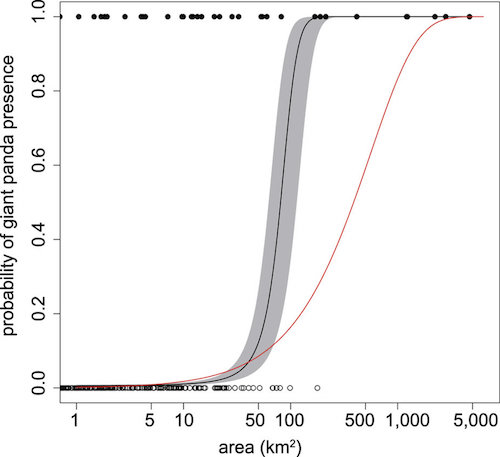Pandas are picky creatures.
They insist on eating bamboo, even though it is not particularly nutritious since their gut flora is not well adapted to it. In captivity, they are choosy with whom they will mate, sometimes preferring not to mate at all. And in the wild, they live largely (though not exclusively) solitary lives.
Now, it appears that pandas have yet another quirk: minimum area requirements. A new study published in Scientific Reports shows that pandas prefer about 115 square kilometers (44 square miles) of space. Even though smaller areas of habitat are available, pandas are less likely to live there.
The authors examined five of the six regions of the world in which pandas dwell. These regions contain fragmented habitats, which allowed the researchers to measure the size of the habitat as well as the probability of finding pandas living there. In all, they analyzed 5,569 habitat patches, which represented a total area of more than 15,000 square kilometers.

The figure plots the probability of finding pandas (y-axis) against the size of the habitat patch (x-axis). Black dots represent the presence of pandas, and open circles represent the absence of pandas. Their logistic regression model (black line) showed that, in order to have a 90% chance of finding a panda, a habitat needed to be roughly 115 square kilometers (44 square miles) in size. (The red line represents the expected probabilities of finding pandas if they did not have a minimum area requirement.)
The message for conservationists is clear: Protecting the panda requires the preservation of large, contiguous living spaces, plenty of low-nutrition food, and proper matchmaking services. Good luck.
Source: Jing Qing et al. "The minimum area requirements (MAR) for giant panda: an empirical study." Scientific Reports 6, Article number: 37715. Published: 8-Dec-2016. doi:10.1038/srep37715




